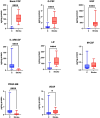Salivary chemokines and growth factors in patients with ischemic stroke
- PMID: 40221607
- PMCID: PMC11993640
- DOI: 10.1038/s41598-025-97974-5
Salivary chemokines and growth factors in patients with ischemic stroke
Abstract
Stroke is a serious health problem that affects an increasing number of people. As a result of the blockage of blood flow, tissue necrosis occurs in areas of the brain supplied by the damaged vessel, and leads to the development of inflammation. Changes that occur in the brain allow molecules to enter the blood, and it has been suggested that some can also penetrate the saliva. This study is the first to assess the profile of 25 chemokines and growth factors in the saliva of stroke survivors compared to a control group. 22 stroke survivors and 22 individuals matched by age and gender were enrolled in the study. Salivary chemokines and growth factors were assessed using the multiplex ELISA method. In the unstimulated saliva of stroke patients, we demonstrated significantly higher levels of chemotactic factors (CTACK/CCL27, IL-8/CXCL8, MIG/CXCL9, MIF) and growth factors (basic FGF, G-CSF, HGF, LIF, VEGF) compared to controls. The levels of MCP-3/CCL7, eotaxin/CCL11, IP-10/CXCL10, IL-3/MCGF, and PDGF-BB were lower in the saliva of the study group. The concentration of basic FGF negatively correlated with cognitive function as measured by the Addenbrooke's Cognitive Examination (ACE) scale (p = 0.007 r = - 0.56), while salivary IL-3 and LIF levels positively correlated with scores on the Functional Independence Measure (FIM) scale (p = 0.019 r = 0.53; p = 0.033 r = 0.47, respectively). Receiver Operating Characteristic (ROC) analysis showed that salivary basic FGF, HGF, IL-3 and LIF can distinguish ischemic stroke patients from the control group with high sensitivity and specificity. In conclusion, disruptions in chemokine and growth factor levels in saliva may suggest an inflammatory etiology of ischemic stroke. Salivary basic FGF, HGF, IL-3 and LIF could serve as potential biomarkers for stroke. Further research is needed to illuminate the differences in salivary inflammatory mediator profiles in stroke and to evaluate the diagnostic utility of chemokines and growth factors in clinical practice.
Keywords: Biomarkers; Chemokines; Growth factors; Saliva; Salivary diagnostics; Stroke.
© 2025. The Author(s).
Conflict of interest statement
Declarations. Competing interests: The authors declare no competing interests.
Figures





Similar articles
-
The screening assessment of pro-inflammatory, anti-inflammatory, Th1, Th2 and Th17 cytokines in saliva of patients with ischemic stroke.Int J Med Sci. 2025 May 28;22(11):2686-2699. doi: 10.7150/ijms.110452. eCollection 2025. Int J Med Sci. 2025. PMID: 40520895 Free PMC article.
-
Changes in chemokine and growth factor levels may be useful biomarkers for monitoring disease severity in COVID-19 patients; a pilot study.Front Immunol. 2024 Jan 4;14:1320362. doi: 10.3389/fimmu.2023.1320362. eCollection 2023. Front Immunol. 2024. PMID: 38239363 Free PMC article.
-
Could inflammation contribute to salivary gland dysfunction in patients with chronic heart failure?Front Immunol. 2022 Oct 10;13:1005981. doi: 10.3389/fimmu.2022.1005981. eCollection 2022. Front Immunol. 2022. PMID: 36300113 Free PMC article.
-
Cytokine and Chemokine Concentration in the Tear of Patients with Age-Related Cataract.Curr Eye Res. 2020 Sep;45(9):1101-1106. doi: 10.1080/02713683.2020.1715445. Epub 2020 Jan 24. Curr Eye Res. 2020. PMID: 31928443
-
Salivary cytokine profile in patients with ischemic stroke.Sci Rep. 2021 Aug 25;11(1):17185. doi: 10.1038/s41598-021-96739-0. Sci Rep. 2021. PMID: 34433866 Free PMC article.
References
-
- Prendes, C. F. et al. Burden of stroke in Europe: An analysis of the global burden of disease study findings from 2010 to 2019. Stroke55 (2), 432–442. 10.1161/STROKEAHA.122.042022 (2024). - PubMed
MeSH terms
Substances
Grants and funding
LinkOut - more resources
Full Text Sources
Medical
Research Materials
Miscellaneous

